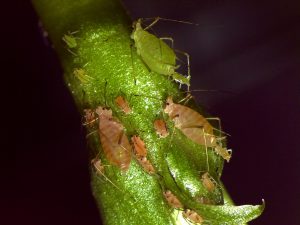Investigating how symbiosis generates biodiversity
Symbiotic relationships can become obligate where neither parter can persist without the other. These heritable obligate symbionts are often clonal and vertically transmitted and therefore experience high levels of genetic drift and accelerated rates of mutation accumulation. One main evolutionary consequence of endosymbiosis is reduction in genome size via gene loss and removal of excess non-coding DNA. Thus symbionts experience genome degradation that likely compromises fitness unless hosts are able to compensate for the functional deficits of symbionts.

Many insects feeding on plant-sap rely on bacterial endosymbionts to synthesize and provision hosts with amino acids and vitamins that are lacking from their diet. The model system to study obligate symbiosis is between aphids and their obligate bacterial endosymbiont Buchnera aphidicola (Gammaproteobacteria). Our lab uses a combination of experimental, molecular, and bioinformatic approaches to study aphids (and other sap-feeding insects) and their microbial symbionts to understand the functional genomics and co-evolutionary dynamics of symbiosis.